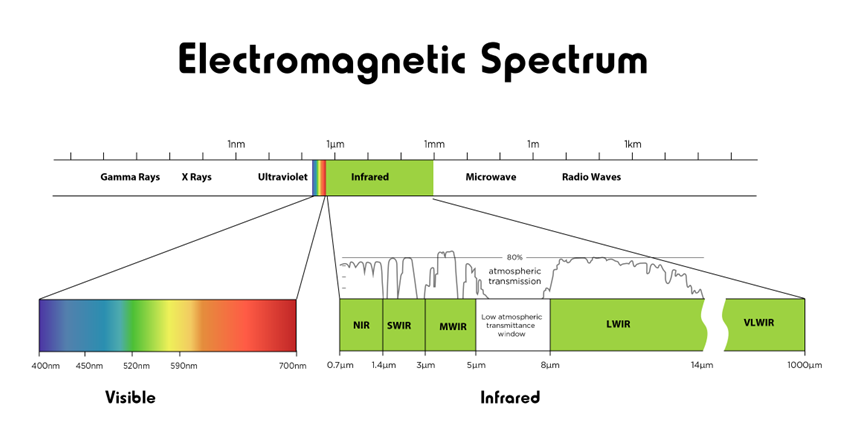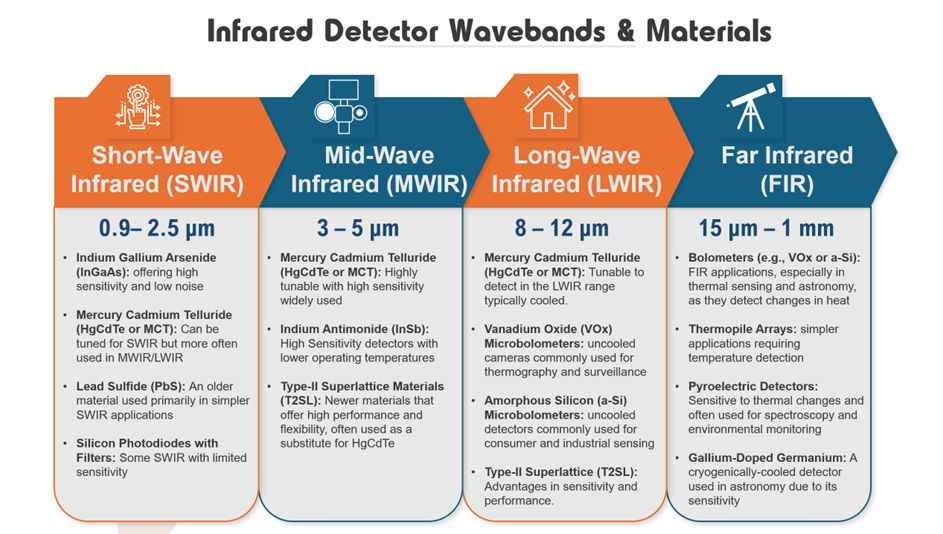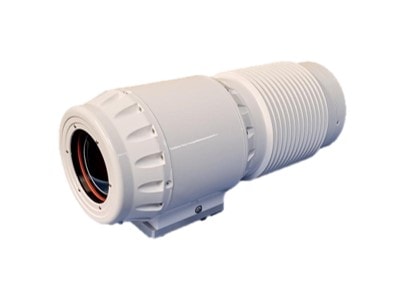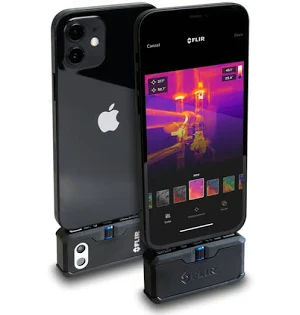Infrared Tech: Seeing Beyond the Visible Spectrum
What is Infrared Tech?
Infrared technology uses sensors to detect both emitted and reflected infrared light, converting invisible heat signatures into visible images. Long-wave and mid-wave infrared capture emitted heat, while short-wave and mid-wave also capture reflected light, making them ideal for low-light or hazy conditions. This versatility supports 24/7 intelligence, surveillance, medical diagnostics, industrial inspection, and environmental monitoring, making infrared essential for imaging, diagnostics, and tracking.
What is Infrared Radiation?
Imagine a world where you could see warmth itself as infrared radiation, where even in the darkest night, the faintest footprints could glow. This is the world infrared (IR) technology unveils.
Infrared exists between visible light and microwave frequency on the electromagnetic spectrum — we experience it as warmth. Infrared sensors allows us to visualize this heat. While invisible to the human eye, infrared light is generated from heat sources, all objects above absolute zero emit infrared energy. IR can also be reflected off of things.
Thanks to IR technology, we now have tools that capture this hidden world, translating heat into visible images. So, let’s dive in and explore how this technology has redefined how we see!

What is the Difference Between SWIR, MWIR, LWIR?
We divided infrared into segments —short-wave (SWIR), mid-wave (MWIR), and long-wave infrared (LWIR)—each spectrum captures specific details based on its wavelengths and have different characteristics and advantages. We measure the wavelength in microns, which is a millionth of a meter. While this is quite small, the wavelength it is approximately 10x longer than visible light on average.

Short-Wave Infrared (SWIR):
SWIR lies closest to the visible spectrum and is transmitted between 0.9 - 1.7 micrometers. It is useful for capturing reflected infrared radiation, making it effective in low-visibility environments like seeing thru fog, haze, and smoke. Industrial inspections, environmental monitoring, and certain medical applications such as cancer detection are ideal applications. SWIR’s ability to capture fine details also aids in sorting materials, identifying contaminants, and analyzing vegetation health.
Mid-Wave Infrared (MWIR):
Mid-wave infrared detectors, positioned in the middle of the IR spectrum. MWIR Covers wavelengths between 3 - 5 micrometers, commonly used for detecting thermal differences. MWIR is ideal for detecting both emitted and reflected infrared light.
MWIR is widely used in military and surveillance applications, where it can clearly detect warm objects against cooler backgrounds, such as people or vehicles at night. This spectrum’s sensitivity to temperature variations makes it suitable for monitoring industrial processes, identifying overheating equipment, and enhancing situational awareness in critical environments.
Long-Wave Infrared (LWIR):
LWIR detectors covers wavelengths between 8 - 12 micrometers, primarily used for night vision and thermal analysis due to its ability to sense thermal radiation at longer wavelengths. It captures subtle temperature differences across surfaces and can show different colors depending on the temperature for some applications.
Its strength in detecting thermal radiation allows LWIR to be highly effective in building inspections, medical diagnostics, and search-and-rescue operations, where it can find people or animals in total darkness. Additionally, LWIR is commonly used in environmental monitoring, such as tracking wildlife, identifying energy losses in buildings, and supporting firefighting efforts.
Far-Infrared (FIR)
Far-infrared detectors typically cover the wavelength range from about 15 micrometers (µm) to 1 millimeter (mm), well past long-wave infrared. It captures lower energy levels and thus is closely associated with thermal emissions from cooler objects. FIR is often used in space for applications like studying thermal radiation from the Earth, environmental monitoring, material analysis and looking deep into space.
What Exactly is Infrared Energy?
Think of Infrared (IR) as light’s mysterious cousin, hanging out right past the red end of the visible spectrum. Infrared radiation, even though you cannot detect IR with the human eye, plays a crucial role in various fields such as imaging and in some optical communications.
You cannot see it, but it is very real—just ask anyone who’s felt the heat from the sun or a hot pan. Infrared waves can be detected and are utilized in various instruments such as thermal night-vision goggles and infrared cameras.
IR breaks down into different categories based on wavelength: short-wave IR (SWIR), mid-wave IR (MWIR), and long-wave IR (LWIR). Each type reveals something unique, from detecting infrared waves to spotting objects in pitch darkness.
How Does an Infrared Cameras Work?
So, how do IR cameras work their magic? An infrared camera doesn’t exactly “see” temperature; instead, it detects IR radiation. This energy is picked up by infrared sensors or detectors, which play a crucial role in converting this energy into electronic signals. With a little digital wizardry, that signal is converted into a thermal image, where warmer areas might glow white and colder areas appear dark. It’s a powerful tool, allowing us to “see” in complete darkness or detect subtle temperature shifts.
What is an IR Illuminator?
An IR illuminator is a device that emits infrared light, invisible to the human eye but detectable by infrared cameras and night vision devices. Used to enhance visibility in total darkness, fog, or smoke, IR illuminators provide the necessary infrared light for night vision cameras and CCTV systems to capture clear images. Unlike traditional lighting, IR illuminators do not cause visual glare or reveal the observer’s position, making them ideal for covert surveillance, wildlife monitoring, and military operations.
A Quick History of Infrared: From Prisms to Night Vision

Our story begins in 1800 with Sir William Herschel, a curious British astronomer. While experimenting with sunlight, Herschel found when he placed a thermometer beyond the visible red end of a spectrum, the temperature rose. This discovery opened the door to infrared light, proving that there was light beyond what we could see within the electromagnetic spectrum.
Fast forward to World War II, where IR technology leapt forward. The military needed night vision to gain the upper hand in low-visibility situations by developing sensors that could detect energy our eye cannot see. These early developments laid the groundwork for today’s IR tech, which has only grown more sophisticated with new sensors that are cooled to ~200 degrees below zero.
Types of Infrared Imaging: Meeting Specific Needs

Depending on what we’re trying to see, we can choose from a few flavors of infrared imaging:
-
Thermal Infrared Cameras: These use LWIR and MWIR sensors to capture small temperature differences, making them perfect for security, surveillance, and even medical diagnostics.
-
Near-Infrared (NIR) and Short-Wave IR (SWIR) Cameras: These use reflected IR energy and are used for industrial inspection and sorting as well as checking crop health as well as some cancer detection. The SWIR cameras are also used to see through fog and haze typically found in coastal regions
-
Specialized Infrared Cameras and Systems: Hyperspectral and multispectral imaging add extra layers of detail for research and environmental monitoring by splitting the the IR bands into slices that can provide information about what the source of the energy is and identifying it.
Additionally, infrared sensors or thermometers are used for measuring temperature in various applications, from industrial settings to medical diagnostics. To do this the thermal energy received by these devices is calibrated to give actual temperatures.

Infrared Technology in Action: Real-World Superpowers
infrared technology has taken on roles in nearly every industry:
-
Aerospace and Defense: Used in surveillance and night vision, these applications are critical for security and mission success.
-
Medical Field: Non-invasive thermal imaging can detect fevers, inflammation, circulation issues, and even detect tumors that are too small to be felt by palpitation.
-
Industrial and Agricultural Applications: Quality control, detecting heat loss, and even monitoring crop health—IR is a silent workhorse. Additionally, Infrared spectroscopy plays a crucial role in analyzing chemical compositions, enhancing the precision and efficiency of these applications.
-
Environmental Monitoring: From wildlife tracking to weather forecasting, IR helps scientists track changes and keep our world in check.
-
Consumer Electronics and Automotive: Ever used face ID or seen a driver-assist system in action? IR tech is quietly powering these everyday conveniences.
Challenges of Infrared Detectors
Infrared technology faces its fair share of obstacles. Infrared sensors, essential components in various applications across multiple industries, are still complex and expensive. And interpreting IR images isn’t always straightforward; environmental noise and atmospheric distortion can make data difficult to analyze.
The Future of Infrared: Boundless Possibilities
Looking ahead, infrared technology is set to go into new applications. Infrared energy detection has potential applications in driverless cars and and other autonomous systems.
Imagine driverless cars that can use IR to detect obstacles in total darkness, or robots equipped with IR “sight” can expand operations around the clock because visible light is not needed to see. Demand for IR systems is growing fast, from automation of everything, to space research, fueled by innovations in material science with AI enabling this even further.